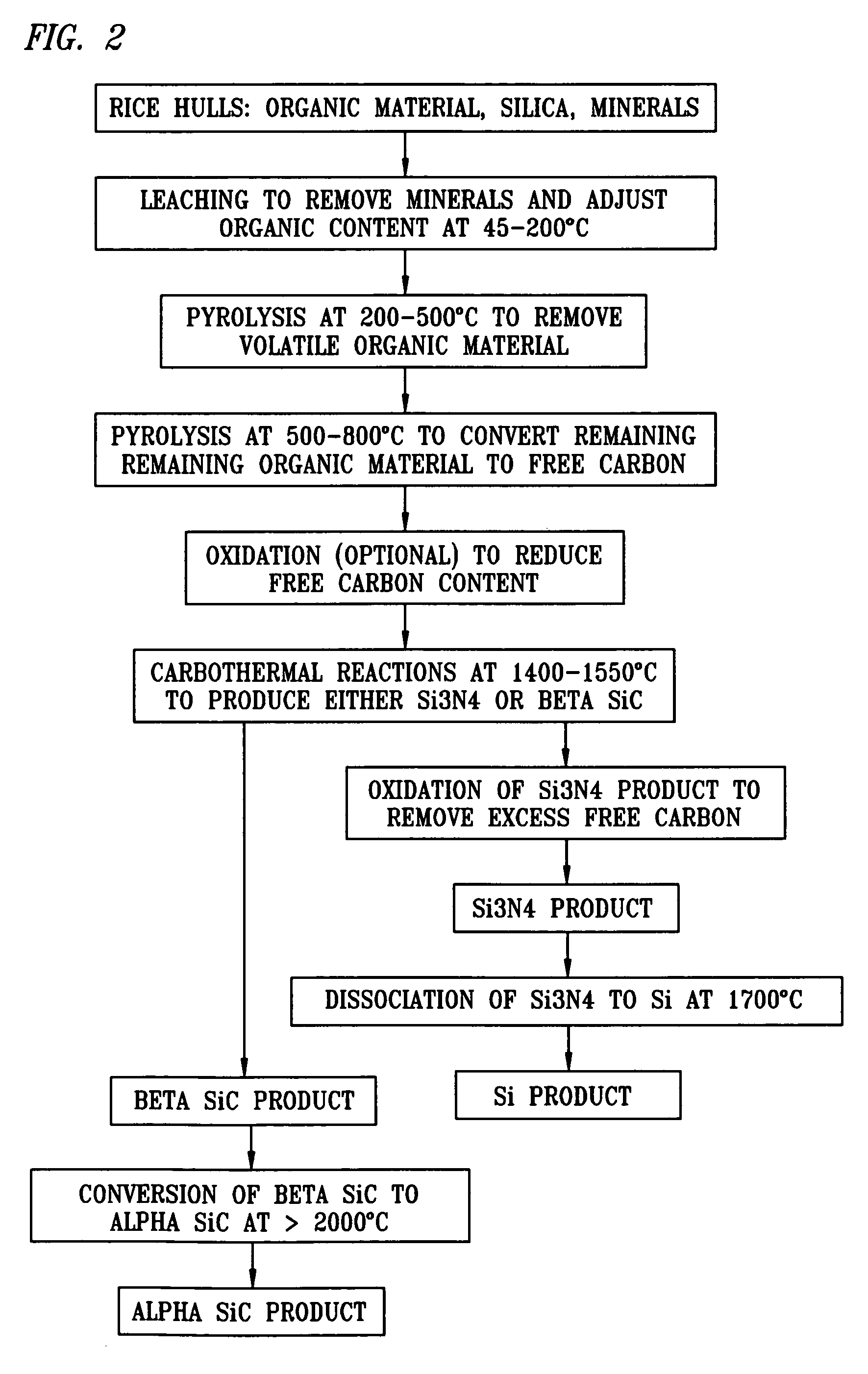Composition and method for making silicon-containing products
a technology of silicon-containing products and compositions, applied in the direction of silicon compounds, carbides, other chemical processes, etc., can solve the problems of increasing the photovoltaic industry, cost of silicon, cost-effective processes, etc., and achieves the effects of reducing processing times and temperatures, reducing energy consumption, and improving processing efficiency
- Summary
- Abstract
- Description
- Claims
- Application Information
AI Technical Summary
Benefits of technology
Problems solved by technology
Method used
Image
Examples
example 1
[0094] Rice hulls were obtained from a mill in Arkansas. The hulls were mixed and then milled in a ring and puck mill to achieve an average particle size of 138 μm. The milled hulls were analyzed via proximate analysis and for SiO2 content. They were found to contain 7.17% moisture, 62.72% volatile carbon, 11.97% fixed carbon and 18.14% ash. The ash was 85% silica (SiO2). The fixed carbon to silica ratio (mole: mole) was 3.88. The volatile carbon to fixed carbon ratio (wt %: wt %) was 5.24. The milled hulls were also analyzed for mineral content by spark source mass spectroscopy and contained amounts of the specified minerals as shown in Table 1.
TABLE 1ElementppmNa400K>10,000Mg>2000Ca2000Mn>2000Fe250B1P>10,000Total>26,651
A 1% sulfuric acid solution was prepared using demineralized water. The acid solution containing 10% milled rice hulls was added to a 2 liter zirconium reactor and heated to 120° C. Once at reaction temperature, the contents of the reactor were sampled frequently. ...
example 2
[0096] A 1% sulfuric acid solution was prepared using demineralized water. The acid solution containing 10% milled rice hulls was added to a 2 liter zirconium reactor and heated to 160° C. Once at reaction temperature, the contents of the reactor were sampled frequently. The samples were immediately filtered and washed with demineralized water. The solids were dried and saved for analysis along with the filtrate.
[0097] The dried solids were analyzed by proximate analysis and silica analysis. The analyses showed that the fixed carbon to silica mole ratio at 180 minutes was 3:1, which is the theoretical ratio for the production of silicon carbide. The solids, analyzed by atomic absorption spectroscopy and colorimetric tests, contained amounts of the specified minerals as shown in Table 3:
TABLE 3ElementPpmNaKMgCaMnFe20PTotal
Thus, the overall percent removal of the specified minerals using a single stage of leaching was greater than 99.7%, yielding a product with a mineral impurity ...
example 3
[0098] A 1% sulfuric acid solution was prepared using demineralized water. The acid solution was added to a 3-liter Pyrex resin kettle and heated to 94° C. Once at temperature, milled rice hulls were added to the kettle to create a mixture with 10% solids. The milled hulls were immediately incorporated into the acid solution producing a well-mixed slurry. The reaction was carried out for five minutes. At the end of this time, the contents of the kettle were filtered and washed with demineralized water. The resulting solid material was dried. This procedure was repeated four more times. The dried solids from each run were combined.
[0099] The fixed carbon-to-silica mole ratio of the combined carbon-silica product was 2:51:1, which is between the theoretical ratio for producing silicon carbide and the theoretical ratio for producing silicon nitride. Malvern analysis of the material indicated a d50 particle diameter of 114 um.
PUM
| Property | Measurement | Unit |
|---|---|---|
| Fraction | aaaaa | aaaaa |
| Fraction | aaaaa | aaaaa |
| Fraction | aaaaa | aaaaa |
Abstract
Description
Claims
Application Information
 Login to View More
Login to View More - R&D
- Intellectual Property
- Life Sciences
- Materials
- Tech Scout
- Unparalleled Data Quality
- Higher Quality Content
- 60% Fewer Hallucinations
Browse by: Latest US Patents, China's latest patents, Technical Efficacy Thesaurus, Application Domain, Technology Topic, Popular Technical Reports.
© 2025 PatSnap. All rights reserved.Legal|Privacy policy|Modern Slavery Act Transparency Statement|Sitemap|About US| Contact US: help@patsnap.com



